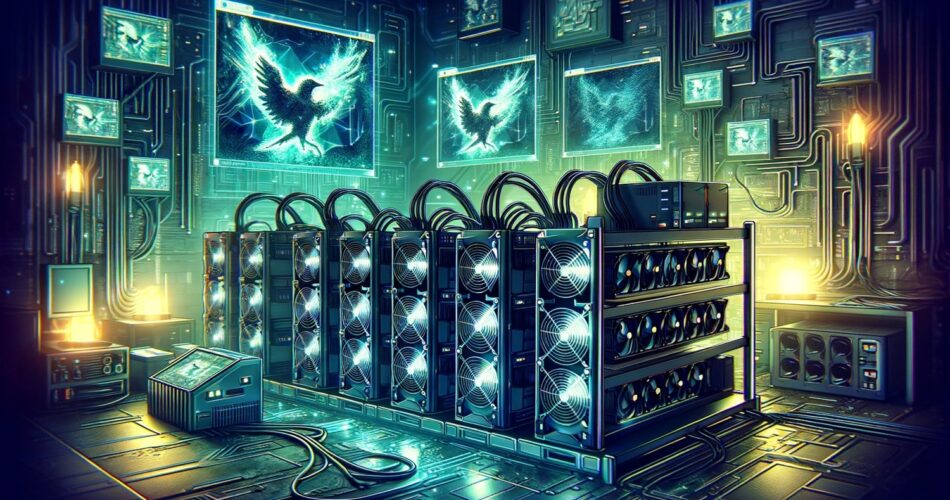In our comprehensive exploration of the cryptocurrency world, we’ve delved into various aspects of Ravencoin, from Where to Buy Ravencoin to Ravencoin wallet choices and mining methods. Our focus now shifts to a pivotal aspect of this digital currency – the Ravencoin Algorithm, with a special emphasis on its latest evolution: the KAWPOW algorithm. This advancement has already made a significant impact, particularly for AMD GPU miners, and represents a crucial step in challenging ASIC mining dominance.
Table of Contents
Ravencoin: A Primer
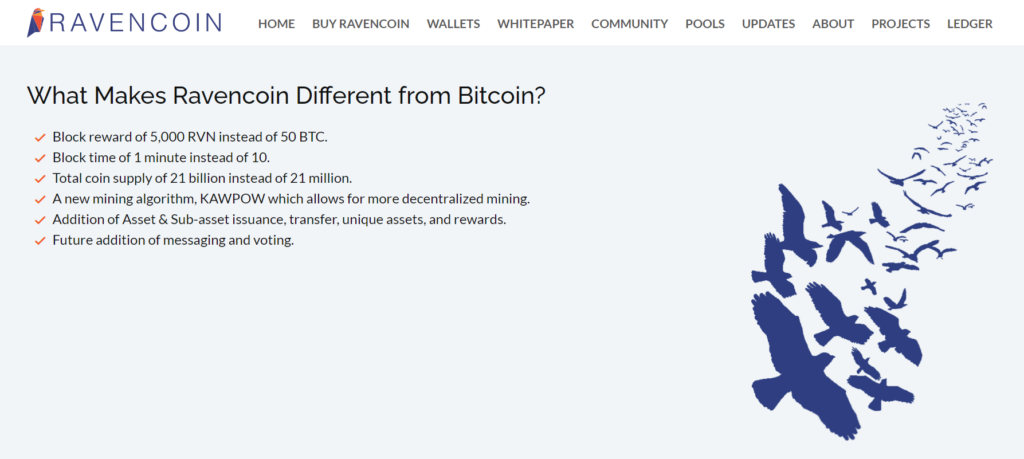
Ravencoin, a digital currency inspired by Bitcoin, has carved out its own path in the blockchain world. It’s not just another cryptocurrency; it’s a specialized network focused on the efficient transfer of assets. Unlike Bitcoin, which is often seen as digital gold, Ravencoin positions itself as a facilitator of asset transfer, making it unique in the blockchain ecosystem.
With the integration of the KAWPOW algorithm, Ravencoin has taken a significant step forward. This move not only underscores its commitment to equitable mining practices but also strengthens its core mission: to enable seamless and secure asset transfers on a decentralized platform. Ravencoin, with its distinct focus and innovative approach, continues to be a noteworthy player in the broader narrative of digital currencies.
The Core: Ravencoin Algorithm
The Genesis: From X16R to KAWPOW
Initially, the Ravencoin Algorithm was built upon the X16R and X16Rv2 frameworks. These algorithms were innovative in their approach to prevent ASIC dominance in mining. However, the evolving landscape of blockchain technology necessitated (some companies made an ASIC for X16R algos) a more robust solution, leading to the development and adoption of KAWPOW.
KAWPOW: A Strategic Evolution
KAWPOW, a derivative of the ProgPOW algorithm, represents a significant leap in Ravencoin’s algorithmic approach. Tailored specifically for Ravencoin, KAWPOW is designed to level the playing field between ASIC and GPU miners, with a particular focus on enhancing the efficiency of AMD GPUs.
Democratizing Mining
The shift to KAWPOW is more than a technical upgrade; it’s a move towards democratizing the mining process. By minimizing the efficiency gap between different types of mining hardware, KAWPOW aims to prevent any single group from monopolizing the mining process, thus upholding the decentralized nature of the network.
Maintaining Network Integrity
At the heart of the transition to KAWPOW is the goal of maintaining the security and integrity of the Ravencoin network. This algorithm ensures that the network remains secure against potential threats and vulnerabilities, a critical aspect in the trust and reliability of any cryptocurrency.
Ravencoin Algorithm Specifications
The KAWPOW algorithm, used in Ravencoin, introduces several key innovations that distinguish it from its predecessor, Dagger Hashimoto. These innovations are specifically designed to optimize the algorithm for GPU mining and to mitigate the advantages of ASIC miners. Below is a detailed chart that breaks down these major innovations and their implications for the Ravencoin algorithm.
| Innovation | Description | Impact on Mining |
|---|---|---|
| Reduced Keccak Size | Transition from 64-bit keccak-f1600 to 32-bit keccak-f800 | Optimizes for 32-bit platforms, aligning well with graphics card architecture, making it more efficient for GPU mining. |
| Larger Mix State | Increased number of processor registers for storing intermediate values | Enhances processing speed as registers are faster than RAM. ASICs, with fewer registers, are forced to rely on slower RAM, reducing their efficiency advantage. |
| Random Computing Sequence | Addition of a random sequence in the main loop | Prevents the creation of ASICs with fixed-function pipelines, which could otherwise increase operation speed or reduce power consumption. |
| Support for Small-Sized Random Cache Reads | Facilitates cached reading with minimal delay | Forces ASICs to adhere to GPU memory hierarchy rules, limiting their performance and capacity. |
| Increased DRAM Requirement | Expansion of DRAM usage from 128 bytes to 256 bytes | Benefits GPUs as specialized ASICs cannot optimize their memory controllers for a small number of references, thus losing their edge in performance. |
Who Created the RVN Algorithm?
The Ravencoin algorithm, particularly its transition to KAWPOW, is the result of collaborative efforts by innovative minds in the cryptocurrency mining sector. Understanding the origins and contributions of these creators provides insight into the algorithm’s design philosophy and its impact on the mining community.
The ProgPoW Genesis: IfDefElse Team
The foundation of the KAWPOW algorithm lies in ProgPoW, developed by the IfDefElse team. This team comprises individuals known as Ms. If, Mr. Def, and Mr. Else, who prefer to keep their identities concealed, with the exception of Ms. If, whose real name is Kristy-Leigh Minehan. The team’s focus has been on developing proof-of-work mining algorithms that democratize mining and reduce the efficiency gap between different types of mining hardware.
Kristy-Leigh Minehan: A Key Contributor
Kristy-Leigh Minehan, a prominent figure in the cryptocurrency mining world, has been instrumental in the development of ProgPoW. Her involvement with OhGodACompany — a collective of individuals providing optimizations and consultancy in the mining sector — has been pivotal. This group has worked with major industry players like Genesis Mining, Nebulous Labs, AMD, NVIDIA, and others, offering optimizations and technical solutions.
OhGodACompany’s Innovations
OhGodACompany is known for its contributions to mining optimizations, including the creation of OhGodAnETHlargementPill. This tool applies optimizations to AMD architecture, similar to those Minehan and her team have developed for other platforms. Their work has also extended to Mineority, a platform aimed at leveling the playing field for smaller miners by providing access to high-quality hardware and software solutions.
ProgPoW’s Impact on Mining Optimization
Despite ProgPoW potentially rendering many of Mineority and OhGodACompany’s optimizations less effective, especially in the realm of FPGA and ASIC optimization, Minehan supports it. She recognizes its importance in addressing the issue of centralized hardware in cryptocurrency networks, emphasizing the need for a more balanced and decentralized mining ecosystem.
KAWPOW and Ravencoin: The Role of Blondfrogs
The adaptation of KAWPOW for Ravencoin was spearheaded by a developer known as Blondfrogs, who is associated with Medici Ventures. His work in tailoring the KAWPOW algorithm specifically for Ravencoin has been crucial in ensuring that the coin remains ASIC-resistant and accessible to a broader range of miners, particularly those using GPU setups.
Ravencoin Algo Miners
The mining landscape for Ravencoin (RVN) has evolved significantly with the implementation of the KAWPOW algorithm. This change has opened up new avenues for miners, with various software options catering to different hardware setups. Below is a detailed look at some of the best mining software available for Ravencoin, along with their respective fees.
Choosing the Right Mining Software
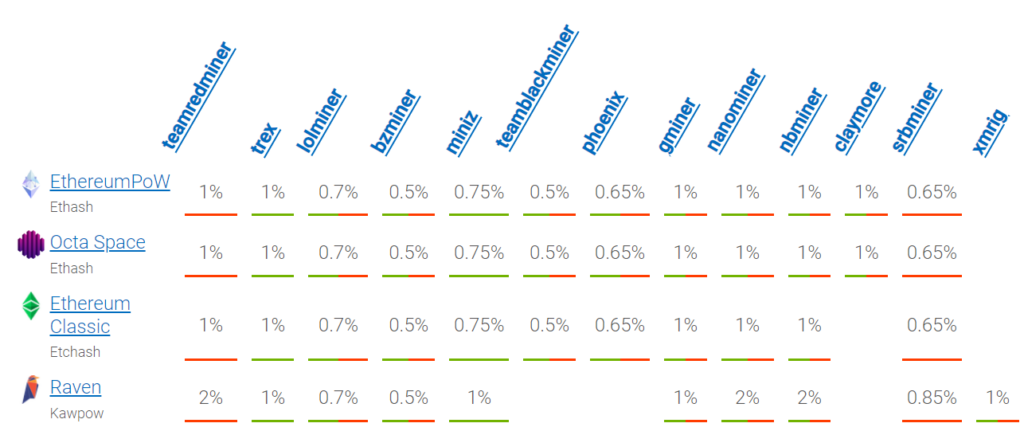
Selecting the appropriate mining software is crucial for efficiency and profitability. Factors such as the type of GPU (AMD or Nvidia), fee structure, and software performance play a significant role in this decision. Here’s a breakdown of some popular mining software options for Ravencoin:
Chart: Ravencoin Algo Mining Software Comparison
| Mining Software | Compatible Hardware | Fee |
|---|---|---|
| TeamRedMiner | AMD | 2% |
| T-Rex Miner | Nvidia | 1% |
| lolMiner | AMD + Nvidia | 0.7% |
| BzMiner | AMD + Nvidia | 0.5% |
| GMiner | AMD + Nvidia | 1% |
TeamRedMiner (AMD)
TeamRedMiner is specifically optimized for AMD GPUs. It’s known for its stability and performance, albeit with a slightly higher fee of 2%. This software is a popular choice among AMD users for its consistent updates and support.
T-Rex Miner (Nvidia)
T-Rex Miner caters to Nvidia GPU miners. With a 1% fee, it offers a balance between performance and cost. T-Rex Miner is favored for its user-friendly interface and regular updates.
lolMiner (AMD + Nvidia)
lolMiner, compatible with both AMD and Nvidia hardware, charges a 0.7% fee. It’s a versatile option for miners who have mixed hardware environments or those who prioritize lower fees.
BzMiner (AMD + Nvidia)
BzMiner also supports both AMD and Nvidia GPUs and stands out with the lowest fee of 0.5%. This software is an excellent choice for miners looking to maximize their profits with minimal fees.
GMiner (AMD + Nvidia)
GMiner is another versatile option for both AMD and Nvidia users, charging a 1% fee. It is known for its high performance and efficiency, making it a strong contender in the mining software market.
The Impact of KAWPOW on Mining
The Ravencoin algorithm’s impact on mining is multifaceted. While it democratizes the mining process and makes it more accessible, it also introduces new challenges in terms of heat management, power efficiency, and hardware maintenance. Miners venturing into KAWPOW mining need to be well-prepared and proactive in managing these aspects to ensure a successful and profitable mining operation.
Heat Generation and Power Sensitivity
One of the notable characteristics of KAWPOW is its tendency to generate substantial heat during the mining process. This aspect is particularly crucial for miners to consider, as it directly impacts the hardware’s longevity and efficiency. KAWPOW’s high heat output demands exceptional ventilation and cooling solutions in mining setups. Miners need to ensure that their mining environment is well-ventilated to prevent overheating, which can lead to reduced performance or even hardware failure.
Power Consumption and Efficiency
In addition to heat generation, KAWPOW is also extremely power-sensitive. This means that the algorithm’s performance and profitability are closely tied to the power efficiency of the mining setup. Miners need to strike a balance between power consumption and mining output to maintain profitability. This might involve fine-tuning the hardware settings, such as adjusting the power limits and clock speeds, to optimize for the best power-to-performance ratio.
Impact on Mining Hardware Components
An unexpected consequence of mining with KAWPOW is its impact on certain hardware components, particularly the risers. Risers, which are used to connect multiple GPUs to the motherboard, have been reported to fail more frequently under the strain of KAWPOW mining. This phenomenon has been observed by many in the mining community, including personal experiences where approximately 5% of all risers needed replacement after mining with KAWPOW. This increased wear and tear on the risers is an important consideration for miners, as it adds to the maintenance cost and effort required in a mining operation.
Preparing for KAWPOW Mining
Given these factors, miners interested in Ravencoin and the KAWPOW algorithm need to prepare their setups accordingly. This preparation involves investing in robust cooling systems, optimizing power settings, and being ready for potential increased maintenance, especially concerning risers and other sensitive components. While KAWPOW offers a more democratized mining environment, it also demands a more nuanced and careful approach to hardware setup and maintenance.
Exploring Other Ravencoin Algorithm Coins
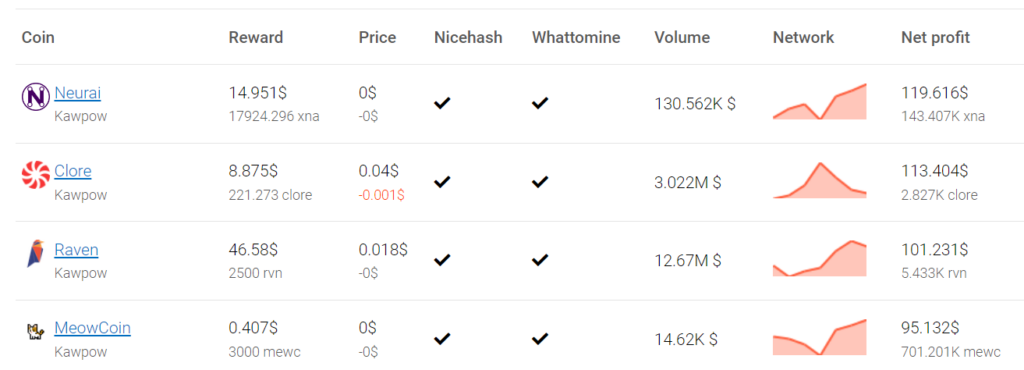
The Ravencoin algorithm, particularly with its KAWPOW iteration, has not only revolutionized Ravencoin mining but also influenced a variety of other cryptocurrencies. These coins, leveraging the same algorithmic principles, offer diverse opportunities for miners and investors alike. Among them, Clore, Neurai, Meowcoin, and Neoxa stand out for their unique features and growing popularity. Notably, the first three can be mined on the Woolypooly mining pool, a platform known for its efficiency and miner-friendly features.
Clore (CLORE)
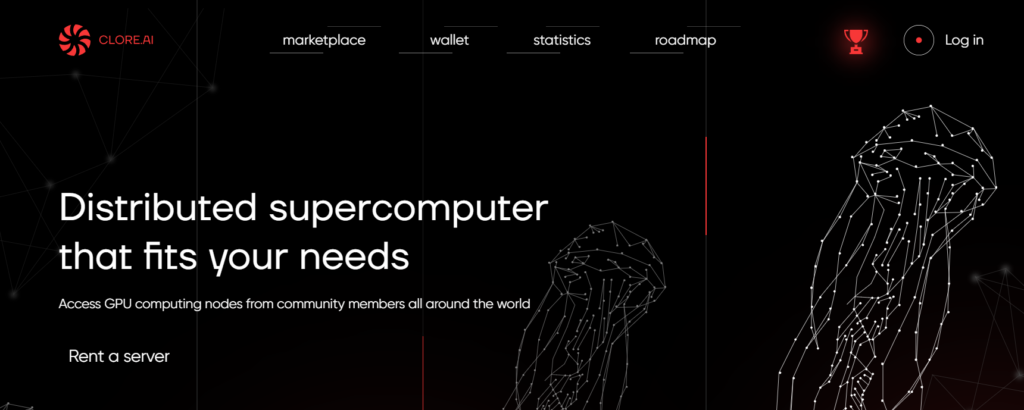
Clore is a cryptocurrency that has adopted the Ravencoin algorithm. It aims to offer a decentralized GPU marketplace. As with Ravencoin, Clore benefits from the ASIC-resistant nature of the KAWPOW algorithm, making it an attractive option for GPU miners. The coin’s focus on mining and AI Training adds to its appeal in the crypto market.
Neurai (NRUI)
Neurai, another coin utilizing the Ravencoin algorithm, positions itself uniquely in the crypto space. It is designed to support projects and applications in the neural network and AI sectors. By leveraging the security and efficiency of the KAWPOW algorithm, Neurai aims to provide a robust and scalable platform for innovative tech ventures.
Meowcoin (MEWC)
Meowcoin, also known as MEWC, is a cryptocurrency that shares similarities with Ravencoin in terms of mining and transaction processes. It’s particularly popular among miners who are looking for alternatives to mainstream coins but still want to utilize their existing Ravencoin-compatible mining setups. Meowcoin offers a fun and engaging community, adding a lighter touch to the often serious world of cryptocurrency.
Neoxa (NEOX)
Neoxa is another notable cryptocurrency that employs the Ravencoin algorithm. It is designed to be a versatile and user-friendly digital currency, catering to a wide range of applications and users. Neoxa’s adoption of the KAWPOW algorithm ensures that it remains accessible to a broad base of miners, further supporting its goal of widespread adoption and use.
Future Prospects and Challenges
The Ravencoin algorithm, particularly with its adoption of KAWPOW, stands at a pivotal point in its journey. As it continues to evolve and adapt to the ever-changing landscape of cryptocurrency, it faces a mix of prospects and challenges that will shape its future.
Sustaining Decentralization
One of the primary goals of the Ravencoin algorithm is to maintain a decentralized mining environment. The challenge lies in sustaining this as the network grows and attracts more attention. The risk of larger mining pools gaining disproportionate influence remains a concern that needs continuous monitoring and algorithmic adjustments.
Technological Advancements
As new technologies emerge, particularly in the realm of blockchain and mining hardware, Ravencoin must adapt to maintain its relevance and efficiency. This includes staying ahead of potential new forms of mining hardware that could threaten its ASIC-resistant nature.
Environmental Considerations
The environmental impact of cryptocurrency mining is a growing concern. Ravencoin, like many other cryptocurrencies, faces the challenge of reducing its carbon footprint while maintaining network integrity and profitability for miners.
Community Engagement and Growth
The strength of any cryptocurrency lies in its community. For Ravencoin, fostering a strong, engaged, and growing community will be vital for its future development and adoption.
Market Competition
Ravencoin operates in a highly competitive market with numerous cryptocurrencies vying for dominance. Staying relevant and attractive to both miners and investors in this crowded space is an ongoing challenge.
Conclusion
As we delve into the intricacies of the Ravencoin algorithm and its transition to KAWPOW, it becomes evident that this journey is more than just a technical evolution. It’s a narrative about the relentless pursuit of decentralization, fairness, and innovation in the cryptocurrency mining space.
The shift to KAWPOW, inspired by the ProgPoW algorithm and tailored by the dedicated efforts of developers like Blondfrogs, underscores a deep commitment to keeping mining accessible and decentralized. This move is a testament to the Ravencoin community’s dedication to ensuring that no single group gains disproportionate control over the mining process, thus preserving the democratic ethos of cryptocurrency.
Ravencoin’s journey is also marked by its ability to navigate challenges through innovation. From addressing the heat and power sensitivities of the KAWPOW algorithm to adapting to the evolving hardware landscape, the Ravencoin community has shown resilience and adaptability. This proactive approach is crucial in an industry characterized by rapid technological advancements and shifting regulatory landscapes.
The development of the Ravencoin algorithm has been a collaborative effort, involving contributions from diverse yet anonymous teams like IfDefElse, led by figures like Kristy-Leigh Minehan, and individual developers like Blondfrogs. This collaborative spirit highlights the importance of community in the cryptocurrency world, where shared goals and collective efforts drive innovation and growth.
As Ravencoin continues to evolve, it faces a future filled with both promising opportunities and significant challenges. The algorithm’s ability to adapt to new technologies, regulatory changes, and environmental concerns will be key to its continued success. Moreover, sustaining a strong and engaged community will be vital in navigating these waters.
FAQs
How does Ravencoin Algorithm impact GPU mining?
Ravencoin Algo (KAWPOW) is optimized for GPU mining, making it more efficient and accessible for individual miners. It requires more memory and processor registers, which are more favorable for GPUs than ASICs, thus reducing the efficiency gap between different types of mining hardware.
How does KAWPOW differ from Ravencoin’s previous algorithms?
KAWPOW is specifically designed to counter ASIC dominance, offering a more balanced mining environment, especially for AMD GPU users.
Are there any specific challenges in mining Ravencoin with KAWPOW algorithm?
Yes, KAWPOW is known for generating substantial heat and being power-sensitive. Miners need to ensure good ventilation and cooling in their setups. Additionally, KAWPOW can cause increased wear and tear on certain hardware components, like GPU risers.
Can other cryptocurrencies be mined using the Ravencoin algorithm?
Yes, other cryptocurrencies like Clore, Neurai, Meowcoin, and Neoxa also use the Ravencoin algorithm. This allows miners to use their existing Ravencoin-compatible setups to mine these coins as well.
